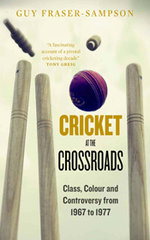Cricket at the Crossroads
Martin Chandler |Published: 2011
Pages: 278
Author: Fraser-Sampson, Guy
Publisher: Elliott and Thompson
Rating: 4 stars

The late 1960s and early 1970s were a time of great upheaval in cricket, as in every other facet of life. For this reviewer, and for Guy Fraser-Sampson, the period also coincided with our formative years as cricket lovers. That is no doubt why Fraser-Sampson, an experienced author albeit not normally on cricket, chose to write about the era, and it also explains in part why I enjoyed his book as much as I did.
Cricket at the Crossroads is, in essence, a chronological trip through the game’s history, from an English perspective, during the turbulent decade between 1967 and 1977. It begins with a long hard look at the reasons why Brian Close had the England captaincy taken from him back in 1967, and ends with the revelations about World Series Cricket that rocked the very foundations of the game, and first emerged during the 1977 Ashes summer.
I particularly enjoyed the analysis of Close’s sacking, which must be viewed as the definitive account of that particular episode. The next major development Fraser-Sampson deals with, the D’Oliveira Affairwill almost certainly never have the benefit of such certainty, but while this is a subject that has been tackled more than once in the last forty years, it remains a compelling one, and the author does succeed in adding a few interesting insights of his own.
The highlight of the book is the treatment it gives to Ray Illingworth’s feat, in 1970/71, of leading an England side that regained the Ashes in Australia. The relative lack of interest that has subsequently been shown in that series has always baffled me, the more so after reading Fraser-Sampson’s thorough account of the many controversies that emerged during the tour.
A constant theme throughout the book is the difficulty that the MCC had in its attitude to the amateur/professional divide through the period, the formal abolition of the distiction in 1962 notwithstanding. One of the English game’s most respected characters, Colin Cowdrey, emerges, in some respects, with a somewhat tarnished reputation, although in truth as much by reason of the words and actions of others as his own well-documented shortcomings.
Another interesting discussion surrounds the issue of intimidatory bowling. John Snow in 1970/71, Lillee and Thomson in 1974/75 and the 1976 West Indian pace battery all helped to keep the issue at the top of the game’s agenda. It is a little frustrating that there are a couple of slightly misleading comments that appear, and while I have little doubt they are unintended, they do detract a little from the authority with which Fraser-Sampson expresses his views. Firstly it was only Nari Contractor’s Test career that ended after the terrible injury he sustained from a Charlie Griffith bouncer in 1962. He continued to play the First Class game for the best part of a decade. In addition the brief digression concerning the Bodyline tour suggests that the limit on the number of fielders permitted behind square on the leg side was a law introduced in response to the English tactics. It would have been a good idea if it had, but more than two decades were to pass before the prohibition was actually introduced.
The book concludes with an epilogue, in the main summing up very briefly what became of the leading characters from its preceding chapters, but also dwelling on the subject of former Labour Cabinet Minister Peter Hain who was, of course, the Chairman of the campaign to stop the 1970 South African tour. If I ever took it on board at the time (1976) that Hain was tried and acquitted on an allegation of robbery from a bank, apparently framed by the South African Secret Service, I had long since forgotten and the three pages devoted to it are a wholly unexpected but nonetheless fascinating look back at a remarkable incident from the not so distant past.
Other excellent recent books, particularly Peter Oborne’s “The D’Oliveira Affair”, and David Tossell’s “Grovel”, do mean that in places Fraser-Sampson treads a well worn path, but despite that the chapters on Ray Illingworth’s time as England Captain, and the 1970/71 tour in particular, make Cricket at the Crossroads well worth four stars. Recommended to all, and an essential purchase for anyone with a particular interest in the period.







Leave a comment